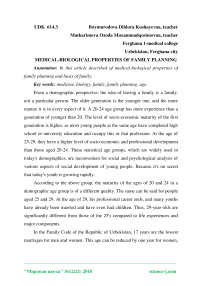Medical-biological properties of family planning
Автор: Boymurodova Dildora Kushayevna, Matkarimova Ozoda Muxammadqosimovna
Журнал: Мировая наука @science-j
Рубрика: Основной раздел
Статья в выпуске: 12 (21), 2018 года.
Бесплатный доступ
In this article described of medical-biological properties of family planning and basis of family.
Medicine, biology, family, family planning, age
Короткий адрес: https://sciup.org/140263247
IDR: 140263247
Текст научной статьи Medical-biological properties of family planning
From a demographic perspective, the idea of having a family is a family, not a particular person. The older generation is the younger one, and the more mature it is in every aspect of it. A 20-24 age group has more experience than a generation of younger than 20. The level of socio-economic maturity of the first generation is higher, as most young people at the same age have completed high school or university education and occupy this or that profession. At the age of 25-29, they have a higher level of socio-economic and professional development than those aged 20-24. These statistical age groups, which are widely used in today's demographics, are inconvenient for social and psychological analysis of various aspects of social development of young people. Because it's no secret that today's youth is growing rapidly.
According to the above group, the maturity of the ages of 20 and 24 in a demographic age group is of a different quality. The same can be said for people aged 25 and 29. At the age of 29, his professional career ends, and many youths have already been married and have even had children. Thus, 29-year-olds are significantly different from those of the 25's compared to life experiences and major components.
In the Family Code of the Republic of Uzbekistan, 17 years are the lowest marriages for men and women. This age can be reduced by one year for women, taking into account the exceptional circumstances, according to local authorities' decision.
Different countries have different marriages of men and women, depending on traditions and national traditions. For example, for men it is between the age of 14 (in some countries in Ireland, Spain and Latin America) - up to the age of 21 (in Poland, Austria, Germany and some Scandinavian countries). The lowest age for women is usually determined by men as some of them younger.
It should be noted that the issue of adolescence and their marital status are sometimes contradictory. The moral and spiritual image of a person, his personal affection, taste, and habits may change several times throughout life. At the present time, accumulation of knowledge and experience is at a very high intensity. Accordingly, it is difficult to consider the age between 16 and 29 as a hormonal period for marriage. There are many objective conditions and contradictory situations that cannot be directly linked to the youth at this time. For example, adolescents aged 14-16, legal age 18, vocational training and professional development often occur at the age of 28-30. In the absence of parental support, achieving economic independence is usually between 20 and 30 years of age. Often older generations are accused of not being ready for life, but at the same time, their objective reasons and circumstances are ignored.
A moderate psychological environment in the family is a prerequisite for a healthy family. Relationships in the family, mutual respect, mutual understanding based on mutual trust, love and devotion create a moderate psychological environment, which is an important factor for the strengthening of the family, This results in a Households' well-being and economic climate have a major impact on the family environment.
Therefore, it is important for the couple to care for increased family income, especially when the man, who is the family member, needs to have a priority in this process. The positive effects of moderate psychological environment and the healthy distribution of family responsibilities between men and women, and the sense of shared responsibility for the upbringing of children, have a positive effect. is a sign of a healthy family. The health of family members depends on how well they are following the rules of healthy living and the presence of dangerous and harmful habits such as smoking, alcohol, and drug abuse. is a symptom of unhealthy family and not only affects the health of the family members, but also the spiritual and spiritual state of the family, the upbringing of children, and the economic well-being of the family.
An important principle for family members to be educated, occupied with their profession, caring for the future of their children, employment in the profession, and the future of the family and the continuation of a healthy family tradition are considered. From the point of view of reproductive health of women, family health and healthy family are closely related to family planning.
Effective demographic and social policy implemented in the country, on the one hand, is aimed at providing financial support to low income families, raising the living standards of the population, employment, creation of new jobs, on the other hand, strengthening the material and technical basis of the employment assistance, providing qualified medical personnel and equipping them with up-to-date equipment. In order to make the full access to the social and economic life of young people, it is necessary to provide them with a wide range of knowledge and skills ". According to researchers, the amount of knowledge young people need to achieve is increasing every 2 years.
The process of transmitting social, moral and scientific-technical experience to the next generation has reached such an extent that it requires at least 12-15 years of education for the full economic development of all ages.
Список литературы Medical-biological properties of family planning
- Allayorov Y.N., Tosheva D.Q., Yusupova D.O‘. Onalikda hamshiralik parvarishi. -Toshkent., 2016.
- Allayorov Y.N. Reproduktiv salomatlik va kontratseptiv texnologiya. -T.: «Istiqlol» nashriyoti, 2005.
- Allayorov Ya.N.,. Rasulova M., Yusupova D.U. Pathological obstetrics. Samarkand, 2007.


